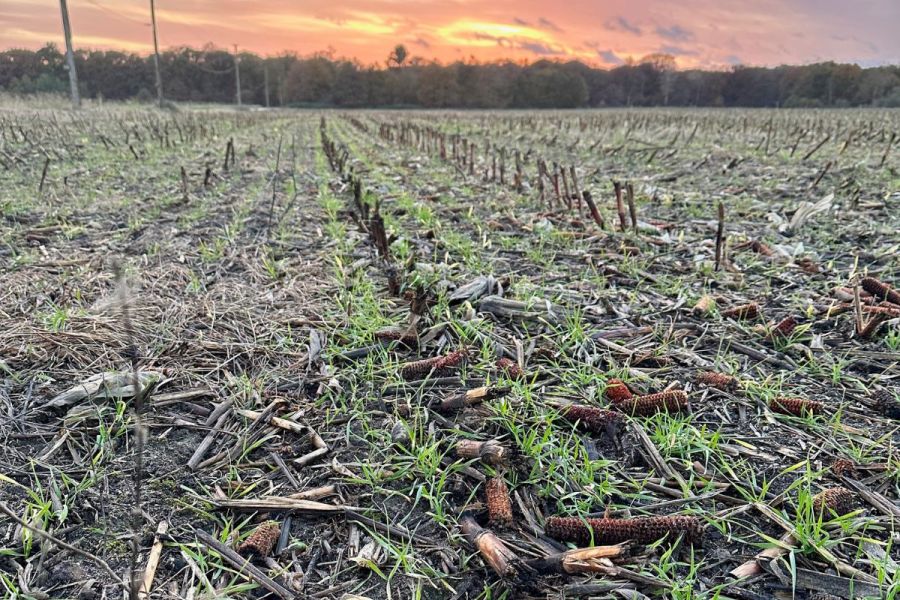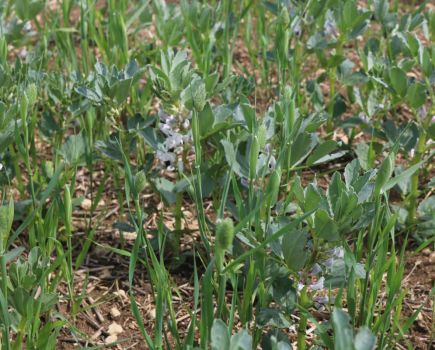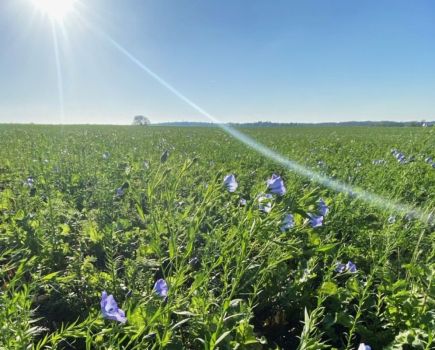French farmer, Frédéric Thomas, is a well-known pioneer of conservation agriculture, not just in his home country, but globally too. CPM joined a BASE-UK trip to see how he puts this into practice on his farm.
“Before I used this system I wasn’t able to grow barley in this soil.”
By Mike Abram
The group is stood together in a field of decent looking winter barley, especially when compared with many of the waterlogged fields seen while driving down to the Loire Valley since exiting the Channel Tunnel.
Direct drilled one month previously in mid-October, the barley roots are already reaching 20cm down into the soil profile. But directly facing everyone is a 5m round pit where no crop is growing. Other similar patches are visible across the field, with a larger area where most of the barley has been uprooted. The cause is wild boars.
“It’s a nightmare,” says Frédéric Thomas, whose 150ha farm lies between Blois and Orléans in the Loire Valley, around 100 miles south of Paris. “In a no-till system, the wild boars cause more weeds and damage to machinery such as sprayers [because of uneven, pitted ground].”
In total, he estimates around one hectare of the 9ha field will have to be written off so far to add to the 25ha he’s stopped farming in recent years. He can claim compensation for the yield lost, but it doesn’t nearly compensate for the other issues being caused, he suggests.
“Last year we were compensated for 42t of maize even after using hunters and having electric fence on the farm. If I’d done nothing, it would have probably been 100t of maize on the ground.”
It’s not the only challenge he’s facing albeit perhaps the most difficult one to manage. Two other issues have shaped how he manages the farm – his time and the difficult soils.
Unusually, Frédéric doesn’t live on the farm, or even close to it; instead, he lives three and a half hours away. That plus other business interests, including editing a French conservation agriculture magazine, TCS, and worldwide calls for his consultancy on the topic, restrict him to working on the farm for three key months of the year – April, July and October.
His solution has been to build what he describes as an ecosystem of partners and collaborators that work together on both his and neighbouring farms. In total, he’s working with seven partner businesses of different sizes. All are separate enterprises, but together they share machinery and advice.
Three partners use Frédéric’s farm for livestock grazing while a fourth has a compost business. He’s also working with a beekeeper. “We try to develop each other because you know that’ll help your own business,” explains Frédéric.
The agronomic challenge provided by his difficult soils has been managed using conservation agriculture practices. A co-founder of BASE (Biodiversity, Agriculture, Soil and Environment) in France in 2000, Frédéric has been using a combination of zero tillage, cover cropping and compost amendments for 25 years on the farm to manage soils that consist of sand over clay and are prone to erosion.
“Water management is the challenge,” he says. Whereas maize is the main cash crop in his rotation, winter barley or triticale follow depending on soil type. Cover crops are used whenever possible while other crops such as oilseed rape, peas and beans are also grown.
A major change in recent years is greater integration of sheep into the rotation to graze cover crops. Frédéric doesn’t own any himself, but through the collaborations with his partners he has access to nearly 400 sheep and some cattle.
“When sheep graze my farm I charge €0.15/ewe/day, which is around €60/year. It’s very cheap [for the grazier]. If it’s cows, it’s €1/cow/day.”
One issue he’s found by bringing sheep into the system is increasing Italian ryegrass populations. “The problem is, as you kill the cover crop and bring fertility, you don’t have the cover [to compete with the Italian ryegrass],” he explains. “The Italian ryegrass likes the sheep manure and it’s started to get out of hand.”
Because some of the Italian ryegrass is beginning to be resistant to glyphosate – INRAE tests suggest 88% resistance to 1080g a.s./ha of glyphosate on selected seeds – it’s meant a recent return to some shallow cultivation.
Resistant Italian ryegrass wasn’t the sole reason for the return of a 4m-wide shallow cultivator, with uneven fields from wild boar damage also playing a part in his decision. “I was losing up to 15,000 seeds/ha of corn because the ground wasn’t flat, and in 2022 with fertiliser costing a fortune combined with high commodity prices, it was looking like a year you couldn’t afford to lose output.”
He was able to reduce his nitrogen requirements in maize to just 30kgN/ha, meaning he could use stock previously bought in 2020 and 2021. “We had a good even stand and the crop wasn’t short of nitrogen, and we started to have better management of the Italian ryegrass.”
He’s also using other crops in the rotation to help with that management. “One is to grow OSR, although it isn’t easy to grow on the farm because of the wet, but now it’s starting to be easier. It allows us to use propyzamide, which helps.”
OSR is following winter barley in the rotation. He plants it with companions, including beans, peas, sunflowers, buckwheat and hairy vetch. “The idea is to keep the vetch because I only use Kerb (propyzamide) and the vetch probably won’t be killed during the winter, so then I harvest both OSR and vetch together.”
When he’s tried this previously the OSR flowers in April, while the vetch flowers later, which extends the flowering season with the pods on top of the OSR. As the soil isn’t particularly suitable for OSR, he’s not had any particular problems with lodging. “My expectation is, if I can get 1.5-2t/ha of OSR and 1t/ha of hairy vetch, I’d be very happy.”
With hairy vetch worth €2/kg, he says he can afford to pay for optical separation. After harvest he incorporates the residue with a tine roller and grazes sheep on the volunteers and regrowth from the middle of August.
Buckwheat and red clover is another option he’s testing, with the buckwheat and subsequently red clover harvested for seed. “It’s amazing how this kind of clover can overcome the Italian ryegrass and the good it’s doing for the soil,” says Frédéric.
In the field grown last year, the yield of clover wasn’t optimal at 200kg/ha because of weevils but the seed was worth €4/kg, plus an extra €150/ha of CAP payments for growing a legume, and €100 of carbon in his carbon programme. “It’s not a bad crop and the risk is very low.”
While Frédéric believes he’s started to bring the Italian ryegrass back under control with the measures he’s taken, he continues to experiment, this year running a cover crop trial on a field following beans and vetch.
Strips of various cover crops were planted in mid-July to assess their impact on Italian ryegrass populations including two varieties of a domesticated ryegrass, which he’ll prevent from heading in the expectation they’ll outcompete the weed population.
Other cover crop species in the trial include oats, forage rye, mustards, and a mix of Austrian fodder peas, beans and vetch. “If you get it right [with a dense cover] you can keep it very clean underneath,” says Frédéric.
One of his collaborators on the farm, José, has been grazing the trial with his sheep which prevents any of the species from heading. The plan is to follow the cover crop with maize, although Frédéric is also evaluating some of the covers as potential entry points into other crops. For example, the forage rye, he thinks, could be grazed over winter and then provide an entry into an early planted cereal.
Further up the field, as the group walks past the cover crop trial, is an example of a typical cover crop mix Frédéric uses. This part of the field is following winter barley and the cover crop was planted in early July.
The first species in the mix to emerge were sorghum, sunflowers, and radish, says Frédéric. “At the end of September, it was dry and the soil was out of nitrogen, so the vetch started to come and overgrow the cover crop. There are a few types of vetch in the mix, and there’s still a lot – it’s impressive.”
In late October and early November, warmish temperatures encouraged mineralisation in the soil and the radish to regrow and flower. Finally, the mix also contains 3kg/ha of red clover, which he expects to provide a mulch into which to drill the following crop of maize and prevent Italian ryegrass from invading.
José is also mob grazing this area with sheep. “They’re going to be here all winter; he’s calculated the number and size of plots that 50 sheep will take to graze,” explains Frédéric.
Compost, if the weather is favourable, will be applied before the maize is planted, which will be direct drilled with his modified Monosem planter if Italian ryegrass populations are under control and the ground is judged to be level enough, otherwise the cover crop will be shallow cultivated.
Maize yields on the farm have varied between 5.5t/ha grain in 2022 in a very dry summer to 8.5t/ha last autumn, rising to 9.5-10t/ha in the best fields under this system, says Frédéric. “My aim is to do 10t/ha dry. For this type of soil, that provides a much better return than any other crop.”
His system allows him to plant maize earlier than otherwise would be possible on these soils, he adds. “One good trick we’ve learned is to measure the temperature of the soil at a depth of 15cm rather than 3cm. If you’re at the right temperature at 15cm, even if it is too cold at the top you can start drilling.”
Improved soil water management, which is essential for his soil type, is the key to being able to drill earlier, he says. “Conventional management gives around 35-40mm of rainwater holding capacity, which is about one week of corn growth in summer. In this system I’m around 150mm in the poorest soils up to 250mm, so you change the world. It means you have five to six weeks of water during the summer.”
On his soil type there’s the temptation to terminate cover crops early to save water, he says. “But the problem is not a lack of water, it’s that your bucket is very shallow, so it’s about increasing the size of the bucket [through growing cover crops longer] so you can refill it more easily.
“By planting maize earlier, I can try to have it flower by 1 July, which means it’s finished by 15 August. I have the next month to dry it down in the field and harvest it in the right conditions and grow barley after.
“Before I used this system I wasn’t able to grow barley in this soil. And by growing barley I get away from the early summer drought – barley is less hurt by June heat than wheat would be – and it’s less sensitive to take-all. So I make better yields with barley and then I usually get sufficient moisture to start a nice cover crop to feed the sheep,” he explains.
This year’s cover crop has provided 7t/ha of dry matter, and around 30-35kgN/tonne because of the high vetch content. “That’s between 200 and 250kg/ha of nitrogen in the cover crop biomass. Around 30% of that is likely to be available to the following maize crop, so 60-70kgN/ha.”
Growing such a cover crop isn’t just dependent on this year’s conditions, but all the fertility that has been built up previously, he says. Measurements of his soil has shown it’s high in mineral organic matter, which is relatively inaccessible to plants and ‘quite high’ in particulate organic matter.
“Particulate organic matter is the one that feeds the soil life that supply fertility. If you have a high C:N ratio it’s good for soil life and you have a good flux of nitrogen. Analysis of three of my fields showed between 170 and 223kgN/ha of potentially mineralisable nitrogen compared with 60 for my neighbour’s field, who is only five years into his cover crop journey.
“That explains the difference between cover crops. My cover crop doesn’t grow because of the seed, but because of the previous cover crops I grew here.
“It means this soil can supply perhaps around 150kgN/ha, plus the 70kgN/ha in the cover crop. Add another 30kgN/ha at drilling to start the crop, you should be able to achieve 10t/ha of maize dry matter,” he concludes.
This article was taken from the latest issue of CPM. Read the article in full here.
For more articles like this, subscribe here.
Sign up for Crop Production Magazine’s FREE e-newsletter here.




